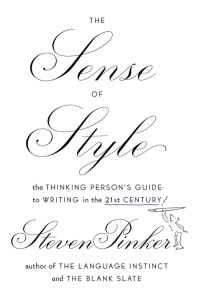 Last month, Steven Pinker’s The Sense of Style was published in Britain and the US. As a specialist on books of usage advice, and as someone who needs to write for a living, I find The Sense of Style interesting because it is partly a book about writing and partly a book with straight-forward usage advice. I also think it’s very important that linguists get more involved in this business of usage advice, and reclaim some authority as it were, from prescriptivists who are underinformed about linguistics.
Last month, Steven Pinker’s The Sense of Style was published in Britain and the US. As a specialist on books of usage advice, and as someone who needs to write for a living, I find The Sense of Style interesting because it is partly a book about writing and partly a book with straight-forward usage advice. I also think it’s very important that linguists get more involved in this business of usage advice, and reclaim some authority as it were, from prescriptivists who are underinformed about linguistics.
I have to admit that I wasn’t overwhelmed by Pinker’s writing advice, which despite much solid guidance, based in linguistics and cognitive science, isn’t always as concrete as I would like it to be. But perhaps this is because as a linguist, some of his insights on how sentences and texts are constructed did not strike me as particularly new or controversial. It probably will for someone without a background in linguistics.
“I love style manuals. Ever since I was assigned Strunk and White’s The Elements of Style in an introductory psychology course, the writing genre has been among my favourite literary genres.”
However, this is not the part of the book that I want to address here. Right now I’m mostly interested in the last – and longest – chapter of the book. “Telling right from wrong” takes up almost a third of the book, and is more or less a usage guide on its own. What I like about this chapter and – the book in general – is the linguistic arguments Pinker uses and the language myths he debunks with them.
“The idea that there are exactly two approaches to usage—all the traditional rules must be followed, or else anything goes—is the sticklers’ founding myth.”
Pinker tackles old chestnuts such as the use of flat adverbs (such as in “drive fast”), and those about the distinction between two and more than two. This category is represented by usage problems such as the use of alternative for more than two choices, the choice between between and among, and each other and one another, and whether or not it is okay to use a superlative in an “X of two”-type phrase (“may the best of the two win”).
Pinker says he loves style manuals. I have a different relationship with them: I think they’re interesting, but I don’t necessarily feel the need to take them home with me. Nevertheless, The Sense of Style will end up on my bookshelf.



How many of the linguistic problems discussed in the final chapter would come into the category of “old chestnuts” would you say? Any new usage problems that Pinker mentions?
Quite a lot. Chapter 6 discusses just over a hundred usage problems, grammatical as well as lexical ones. Pretty much all the “old chestnuts” are included: ain’t, between you and I, dangling modifiers, preposition stranding, shall/will, the split infinitive, that/which, who/whom, very unique, between/among, aggravate, decimate, hopefully, lay/lie, and several others. These alone already bring us to 15% of the usage problems.
And are there any new usage problems, ones that you haven’t come across in your work on the HUGE database?